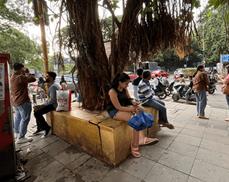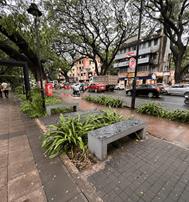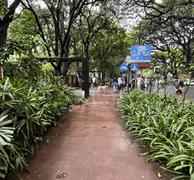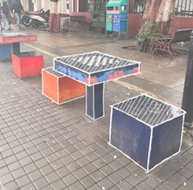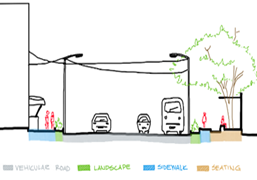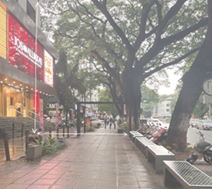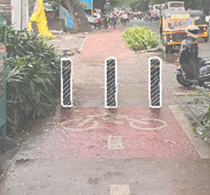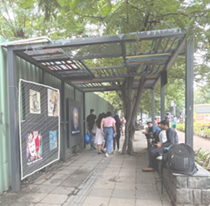ShodhKosh: Journal of Visual and Performing ArtsISSN (Online): 2582-7472
|
|
Investigating The Relationship Between Street Design and Urban Vitality Through ‘Smart-City Initiative’ Case of Pune, Maharashtra, India
Isha Etesh Aghera
1![]()
![]() ,
Dr. Vaishali Anagal 2
,
Dr. Vaishali Anagal 2![]()
![]()
1 Student,
Fourth Year, Dr. B. N. College of Architecture, Pune, Maharashtra, India
2 Associate
Professor, Dr. B. N. College of Architecture, Pune, Maharashtra, India
|
|
ABSTRACT |
||
|
The design and
use of street furniture play a vital role in the design of public places and
in making vibrant urban places. The street and seating area serves as a
public meeting place for a variety of interactions and activities. This study
aims to explore how street furniture can be designed based on its location, and
how it can be improved by comparing real-world scenarios to theoretical
principles. This study takes into consideration the context and surroundings
of the streets developed under the Smart City initiative, as well as their
interaction with the citizen's life. Accessibility, livability, and
connectivity are the defining characteristics of urban vitality. The urban
street design has become more prevalent in locations with obvious commercial
activity. The study aims to investigate the elements of street design and
street furniture and their effect on urban vitality and its relationship with
the surrounding land use. This analysis is done using qualitative methods
such as on-site observations, content analysis of photographs, and walk-along
interviews with the users. |
|||
|
Received 29 August 2023 Accepted 29 December 2023 Published 03 January 2024 Corresponding Author Dr.
Vaishali Anagal, vaishali.anagal@bnca.ac.in DOI 10.29121/shodhkosh.v4.i2
ECVPAMIAP.2023.711 Funding: This research
received no specific grant from any funding agency in the public, commercial,
or not-for-profit sectors. Copyright: © 2023 The
Author(s). This work is licensed under a Creative Commons
Attribution 4.0 International License. With the
license CC-BY, authors retain the copyright, allowing anyone to download,
reuse, re-print, modify, distribute, and/or copy their contribution. The work
must be properly attributed to its author.
|
|||
|
Keywords: Activity Street Mapping, Seating Space, Visual
Image, Urban Vitality, Urban Affairs, Street Pattern |
|||
1. INTRODUCTION
The Ministry of Housing and Urban Affairs (MoHUA) and all state and union territory (UT) administrations collaborated to launch the Smart Cities Mission (SCM) on June 25, 2015. The SCM will increase infrastructure and services while keeping the environment clean and sustainable and boosting urban vitality Aijaz (2021). As part of the Pune Smart City project, 27 km of streets have been designated for redevelopment, and 100 km are covered by the city's yearly budget. In Pune, the initial stage of these street design initiatives has already turned several roadways into lively public areas. By a large majority, Pune residents constantly cite traffic and transportation as their biggest concerns. The street-Road relationship generally prioritizes vehicular traffic and ignores the human quality of street life. By creating an engaging place for pedestrians, street furnishings provide an essential part in the growth of the city. In general, the streets are crowded by vehicles or people walking on the road. Providing a decent walkway and adding urban vitality to it can help to create proper street circulation. The seating space developed aids in increasing social interaction amongst individuals by providing a designated place free of cars. There has been an increase in the use of urban street design in areas where commercial activity is visible. By developing an urban vitality, it adds character to the street while also providing human comfort. The research is divided into four parts. The first is a representation of a literature review on methodologies for analyzing street furniture and urban vitality. The field study is carried out with activity mapping, on-site observations, and interviews with the users. This study aims to investigate the relationship between street design and the surrounding context and how street furniture brings vitality to urban streets.
2. Literature REVIEW
Radwan & Morsi (2016) has attempted to show the importance
of street furniture design and its functionality on the human level. It
demonstrates the significance of blending street and urban design in city
planning. To shed light on the aspects of street design and street furniture,
as well as their impact on the surroundings and given practices from various
countries. The study has concluded how designers seek to create fashionable
street furniture while ignoring its practicality, and usefulness, and how the
immediate surroundings, safety, and materials all contribute to the overall
experience. Yücel (2012) aims to look at the significance of
urban furniture and its connections to public areas. Urban furniture may be
utilized in both unpopulated and densely populated sections of a city. As a
result, urban furniture has become an integral element in cities. It is also
mentioned in the paper that designs that do not reflect the sense of urban
identity may leave pleasant impressions of the space, but in the foreseeable
future, they are short-lived designs that do not represent the historical
nature of the city and cannot effectively develop a contemporary urban image.
Urban
furniture design encourages more social interaction. Street furniture plays a
crucial role in city beautification and aesthetic balance. Additionally, it
describes the vibrant environment that attracts individuals who will spend
hours there for social purposes Allahdadi (2017). In reality, more factors such as
group activities, being visible and participative, and serving as a gathering
spot for people to visit one another impact the development of social
interactions in public areas. The primary purpose of city furniture is to
improve the quality of life for city dwellers by giving them access to
comfortable living areas in their urban environment Şatir & Korkmaz (2005). There exist regions with a wider
focus that argue for emphasizing an integrated strategy for research on city
furniture and urban designs, when two sides of a roadway are rearranged, the
point of view demands that cars and pedestrians’ perceptions should be
evaluated.
Solanki (2021) expressed how much an increase in
attractiveness could encourage urban vitality. Attractiveness, one of the
walkability factors, appears to be crucial in enhancing urban vitality and is
closely tied to urban regrowth. While Urban furniture is a broad group of
objects with various shapes, sizes, and purposes that are used in urban
settings. Additionally, it also examines both practical and visually appealing
solutions as well as the building materials that are most frequently used Grabiec et al. (2022)
‘The impact
of urban form on urban vitality’ Atak (2020) argued that residential areas' urban
form influences whether urban vitality is encouraged or not. However, streets
must be locations where people are meeting, interacting, and engaging in social
activities in order to establish livable and
sustainable cities. Urban vitality promotes street utilization, people to
communicate, and the development of areas that are safe and easy to navigate on
foot.
Aram et al. (2019) examines how UGSs (Urban Green Space)
are used to produce a cooling effect. The intensity of the heat is
significantly reduced by urban green spaces and pause points in urban areas.
According to the paper, the increased buildup of greenhouse gases in the
Earth's atmosphere has caused abrupt changes in global temperature patterns and
the climate. Hence, as a result, all UGSs, including parks, are crucial for
lowering UHI, producing cooling, and giving residents thermal comfort.
Every citizen in a city comes into contact with the street at least
once a day, either physically or with a visual connection. The purpose of the
study is to identify the needs of users in Pune and the type of street
environment they like Patki (2017). Additionally, the research is based
on the comfort and satisfaction of the user. Basar (2021) Finding and analyzing
actual designs of urban furniture that uses renewable energy is the goal of the
study. As a result, it aims to reduce excessive energy usage in city parks,
minimize negative environmental effects, and utilize appropriate renewable
resources as a material for urban street furniture.
The main
design, visual, and physical aspects are evaluated in this study, along with
how they affect the activity pattern, and user behavior.
Pedestrian preferences are closely related to the variety and perceived comfort
of the surroundings, which includes things like facades, colours, aspect
ratios, upkeep, and greenery Balsubramanian et al. (2022). While the suggestion arouses that
some design interventions concerning two public realm Streets and Nodes that
cater to various user groups in a commercial and residential region,
respectively. The standard user theory, which is highly correlated with the
kind of functionality and character of the streets, applies to the urban
streets in many Indian cities. Every module's design is centered
on user comfort, street-appropriate size, and nature Bhaghyalaxmi et al. (2014)
Street
furniture is seen as a crucial component that can be seen in urban space, that
helps people live better lives in urban settings. Usually, the presence of
street furniture encourages pedestrians to visit by providing a necessary
comfort. This paper's major goal is to examine the criteria that should be
taken into account while designing by analysing the demands of users of street
furniture in urban settings Dhaou et al. (2022)
In relation
to the Internet of Things and digitalization, the study presented in this
article reflects the applicability of design and evaluates the performance of
street furniture products. It helps in understanding the present situation with
urban furniture design and the distinctive requirements in the digital context.
The paper explores the effects of the variables on the security of urban
furniture from the viewpoints of urban development, economics, and user groups.
The findings demonstrate that urban furniture, a traditional design field, may
be further modernized and improved against a backdrop of digitalization and the
Internet of Things. It offers new perspectives and assistance for human use and
advanced urban development Yang et al. (2022). Bhat (2022) This research is focused on
understanding the primary open-space criteria on the basis of which the
context's microclimate may be improved. Khorasgani et al. (2023) continues by introducing the
articulated landscape characteristics, relationships with places, and
associated components and elements.
In this study, we qualitatively analyzed the relationship between street design and urban vitality at the city level using visual data to determine where, why, and to what measure we may improve urban vitality.
Two important streets in the city of Pune were selected for this study: Fergusson College Street (F.C. Street) and Jangali Maharaj Road (J.M. Road). They were chosen intentionally for their similarities and differences: First, they were transformed from non-walkable footpaths and street parking areas. Second, they were transformed with similar approaches, such as removing parking, inviting recognizable colorful paintings, green plants, and various types of outdoor urban furniture, such as chess tables, bike racks, and so on. Later, interviews were conducted with persons strolling down the street or utilizing street furniture to learn about their experiences. This analysis is done through the visual data comparison and observation along with street activity mapping. Pune under the smart city initiative has implemented the smart streets project having the potential to redevelop. The analysis and observation can be documented by comparing different locations like JM Road and F.C. Street and doing activity mapping along with understanding the context and surroundings.
Lynch (1960) According to Lynch, every city has a comparable collection of pictures in the minds of those who have experienced it. Based on Lynch’s five characteristics that influence such images, some of them are considered viewpoints on the research area. There are pathways that the observer can go along. This is the aspect of the city that influences people's perceptions of it the most. JM Road and FC Road serve as a path where there is a concentration of uses by people. Landmarks are a different kind of point reference that can only be observed from the outside. Typically, it is referred to as a physical thing, such as a sign, mountain, building, or store. Given the Goodluck Cafe has been located on FC Road since 1935 (Refer to Figure 1), it serves as a landmark for people. The legibility of a city often depends on landmarks since they serve as crucial indicators for everyone in the city to find their way around.
3.1. A CASE STUDY OF PUNE – F.C. STREET
FC is an abbreviation for Fergusson College,
which is an institution. F.C. Street is a fully functional commercial street.
It provides you with commodities from practically every category, including
cuisine, clothing, culture, business, and science. (See Figure 1) A number of educational campuses such as
Gokhale Institute, Fergusson College, Marathwada Mitra Mandal's College, Modern
College of business administration, and Agharkar
Research Institute abutting the streets. Young users are attracted to F.C. Road
for two major reasons: food and clothes.
Figure 1

|
Figure 1 Map of F.C.
Street and J.M. Road Source Street Design Workshop Slideshare.
(n.d.) |
Figure 2

|
Figure 2 Map of F.C. Street and J.M. Road Source Prasanna
Desai architects Oasis Designs. (n.d.) |
Pune smart city development corporation
Ltd. created a roadway that will cater to people of all ages as part of the
smart city program. There is enough space division in terms of vehicular roads,
pedestrian pathways, cycling paths, and sitting areas. At regular intervals, an
equal amount of green landscape area is provided. The prominent observation is
the usage of urban street furniture has increased in regions where commercial
activity is prominent while Seating is not available in certain areas where shops
or restaurants are located.
The research is carried out by
conducting interviews with people walking down the street or using street
furniture to learn about their experiences. Further, the context and
surroundings in which it was studied, as well as its relationship with the
citizen's life were analyzed. Questions were asked of
people while they were using the street furniture.
1)
Are
you able to freely move around the street without any obstructions?
(For example - street lights, bins,
signage poles, etc)
2)
Do
you enjoy walking down this street?
3)
How
frequently do you visit this street?
(To
determine regular users) - once a week/once a month/first visit
4)
Why
have you visited this particular street today?
(e.g.,
passing through, shopping, or eating)
5)
What
is it about this street environment that you enjoy?
6)
Is
there enough shade to sit here during the day?
7)
Which
specific place do you avoid sitting in?
8)
Do
you sense a cultural and artistic and peaceful presence near the seating space?
The number of people interviewed was
nine. And a random process was used to choose individuals for the interviews.
Through this method, it was discovered how frequently visitors visit this place
and their reasons for visiting. The necessity for it as determined by its
location heavily influences how street furniture is used. Regardless of gender,
the majority of visitors were young people in their early 20s who came for a
variety of reasons but mainly for shopping and food.
The
responses elicited are as below:
Table 1
|
Table 1 Field Observations & Interviews
(Case Study: F.C. Street) |
||
|
1. |
|
·
Gender: Male ·
Age: 55-year-old ·
Visiting Time: Every day for one hour ·
He is a heart patient who lives near FC
Street. ·
He likes this street because it has
everything he needs, from food to peaceful shaded pathways |
|
2. |
|
·
Gender: Female ·
Age: 23 to 24-year-old ·
Visiting Time: Once a week ·
They are all friends who meet on FC
Street. They usually visit in the morning or evening, but they have also
visited in afternoon, and they always find shade when they sit wherever. |
|
3. |
|
·
Gender: Female ·
Age: 26-year-old ·
Visiting Time: Twice a week ·
She was looking for a place to wait for
her friend, and the paar under the tree was the
only one she could find that day. Except for this one, there was no seating
on the entire footpath opposite the FC College. |
|
4. |
|
·
Gender: Female ·
Age: 28-year-old ·
Visiting Time: Twice a week ·
She came to the
street for shopping the day I interviewed her. ·
She would not prefer
this designed block because it lacks tree shade and proper shade. And the
blocks are spaced apart so that only one person can sit. |
|
5.
|
|
·
Gender: Female ·
Age: 21-year-old ·
Visiting Time: Once a month ·
She had visited this
place for shopping. She prefers seating area near the FC College to this one
because there is no tree shade, no landscape, and no buffer zone bifurcation
created between the road and footpath. |
|
6.
|
|
·
Gender: Female ·
Age: 25-26-year-old ·
Visiting Time: Twice a month ·
They go to FC Road to
shop and catch up with each other. They prefer the seating area outside FC
College to the one near Wadheshwar because it is
better maintained. |
|
Source Author |
||
Figure 3
Figure 4 Figure 5



|
Figure 3
Landscape Behind
Seating Space Source Author |
Figure 4 Urban Furniture at Different Height Source Author |
Figure 5 Seating Space Under the Tree Shade Source Author |
Table 2
|
Table 2 Visual Analysis and Observations from F.C. Street |
|||
|
No. |
|
|
Observations |
|
1. |
Street-Road
Connection |
|
This
image provides a clear illustration between the sidewalk and the road.
The separation is created through landscape and bollards. The roadside
plantation provides good privacy as well as safety for those using the
footpaths. |
|
2. |
Dark
avoided Space |
|
The
entire pathway is shaded by large old trees that provide shade
throughout the day. However, in some places, it creates a negative dark
space that might have been avoided at night. Part of the reason could
also be the green corrugated sheet on one side. |
|
3. |
Parking
area |
|
A
roadside plantation was missing in some places where urban furniture
was not there due to commercial shops. Instead, a two-wheeler parking
space was accommodated and replaced in that area while still taking the
height of the walkway into consideration. |
|
4. |
Garbage
|
|
There
were separate containers for dry and wet garbage set at equal
intervals throughout the whole roadway. They
were set just alongside the walking path. |
|
5. |
Seating
space near Commercial shops |
|
There
is a commercial section with a busy pedestrian on the opposite side
of the urban furniture street design. The
only seating on that side was beneath the tree, which could only
accommodate 8-10 people. People
had to cross the road after shopping and dining to use the sitting
area provided. |
3.2. A CASE STUDY OF PUNE – J. M. ROAD
Jangali Maharaj
Road (JM Road), like FC Road, is a one-way street with a traffic flow. As a
result, proper vehicular and pedestrian movement is observed. The street is
planned with cycle tracks and large pedestrian paths to allow people to wander
across safely. Each street designated as a public open space must strive to
integrate with all parks, restaurants, landmark buildings, heritage, retail
shops, and so on, to create a cohesive, all-inclusive connected streetscape for
the city.
Figure 6
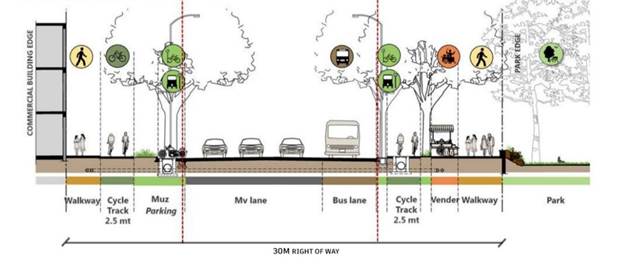
|
Figure 6 Section of Jangali Maharaj Road Source Oasis Designs. (n.d.) |
Figure 7

|
Figure 7 Sketch of Jangali Maharaj Road Source
Author |
Figure 6 shows the section across JM Road
Street helps us understand how green space separates spaces and widen the
pathways. In Figure 7, the segregation of Vehicular and pedestrian and vehicular movement
leads to safety and encourages walk-ability on urban streets.
The
landscape has been used to provide separation for walking paths, footpaths, and
cycling routes. This landscape division allows for a sitting area in between.
While the trees along the walkway cover the entire width of the road and give
shade on bright days. The activity was more concentrated on the commercial
side, with fewer seats occupied. While on the other side of the road, opposite
the business area, is a garden where people of various ages come at various
times to relax and socialize. PMC did not just widen the walkways but also
provided seating spots and fun game areas on the roadside for children. There
is a famous Sambhaji garden on the side of the pathway, which will affect the
usability of the space more with different age groups. While there is a
residential area beside a road with no commercial use, the design of urban
furniture is lacking and the design is impeding the walkway constructed in a
very small space. “As residents can see
the visible change on JM road, many elected members are making demands to
replicate the model in their areas. It is not possible to beautify all the
roads by considering the space available in those areas but wherever possible
PMC will try to execute the same”, said Raut – Indian Politician Tomar (2018)
Table 3
|
Table 3 Visual Analysis and Observations from J. M. Road |
|||
|
No. |
|
|
Observations |
|
1. |
Landscaping near
street furniture |
|
Urban furniture bench
is surrounded by nature and landscape, making us forget that we are
sitting on the side of the road. There is a tree
canopy above and a plantation barrier for a sidewalk. Making it an
absolutely ideal location for an evening stroll. |
|
2. |
Isolated space w.r.t
shrub plantation |
|
The sidewalk is lined
with shrub plantations on both sides, creating an isolated space for
walking and jogging. It also separates the
seating area from the road. |
|
3. |
Safety from vehicles
through a landscape |
|
There is a special
landscape path that separates the seating area and the footpath along
with the road. It creates a barrier
for people looking over the road via urban furniture. It also helps to reduce
noise from vehicles. From the footpath. |
|
4. |
Signages |
|
J.M. Road has more
visible and clear signage at proper intervals while walking. All of the signage is
set precisely, making it easier to understand the space. |
|
5. |
Play area |
|
There are chess
tables for people to come and utilize the space for walking and seating
and not only for using the commercial area but use an outdoor play area. |
|
Source Author |
|||
After the implementation of the smart city project, the street has become a place rather than a space of only vehicular movement. The frequency of visiting the streets has increased although not for the activities surrounding the streets, but people are using the streets as places to meet, chat, and interact. The vehicular and pedestrian movement are segregated so this gives safety for the pedestrian. It's intriguing to explore the unique relationship between street furniture and urban vitality. Sitting inside a city setting offers a chance to pause as well as a physical and more personal connection to a place than one would have while standing or moving around it. The greatest areas for benches are places with high pedestrian traffic, such as shopping mall walkways, transit stations, plazas, and areas outside of institutions and organizations; regions with minimal activity are considered to be in bad places to redesign the street. The street furniture incorporates landscaping to add life and shrub plantings at the edge to protect people from moving vehicles. Bus stations, bike paths, and seating places are also present. The adjoining-built form identity has a significant influence on the street. In terms of tactile blocks, accessibility, etc., the street conditions also benefit those with special needs and benefit all age groups. Proper comprehension of signage for various tasks to optimize user flow and mobility. In Pune, where there is a lot of traffic, bollards are mostly used to prevent vehicles from driving on pavements. Dustbins, bus shelters, etc. are sufficiently distributed around the sidewalk. The urban street pattern was created using a variety of spatial, visual, and sensory approaches.
F.C. Road and J. M. Road have a similar approach in terms of the street pattern but differ in terms of use and context. The commercial area just adjacent to the street is the same in both locations, however the area utilization directly outside the store changes.
Table 4
|
Table 4 Common Observations and Findings |
||
|
Common Observations |
Sketches / Images |
Findings |
|
1.
Street Section |
|
The street section
demonstrates how green space divides areas and broadens routes while
providing safety. |
|
2.
Activity Mapping (Time-
5:00 pm to 7:00 pm) Male:
120-160 Female:
150-180 |
|
The vital urban
environment and perceived safety lead to gender equality in the use of
active streets because of the commercial use |
|
3.
Seating space near the commercial area - |
|
Providing seating
near commercial areas improves the usability and functionality of the
street, as well as the value of the commercial space. |
|
4.
Bollards
- |
|
Bollards are only
positioned to facilitate cycling activity in order to prevent the flow of
road cars onto the sidewalk. It leads to a safe environment and increases
people's walk-ability and urban vitality |
|
5.
Integration
of art in the street |
|
The seating space is
semi-covered with tree shade above which helps on sunny days. A few artistic
paintings are kept to enhance the space along the landscape. |
|
Source Author |
||
5. Conclusions
This study examined the relationship between space usage patterns on urban vitality and street furniture, taking into account the physical characteristics of the street environment, and basing its findings on observations and human experience. Beyond simple comfort, these furnishings' main purpose is to give a location personality and individuality and to entice people to use outside areas. When waiting for transportation, street furniture might provide sitting and shelter, for instance. It may also improve a site's aesthetic elements, image, and identity if properly planned and created. In recent years, high quality in the design of street furniture has drawn attention to landscape design in addition to its functional aspects. Emphasis is now placed on the fusion of function and aesthetics with new materials and technologies, creative concepts, and artistic applications in the user-friendly urban landscape. With the help of street furniture, a city may develop a stronger sense of community and become a place where people can meet, interact, and share in daily life. Having badly designed street furniture highlights a city's disorder, lack of cohesion, and sense of community. In recent years, cities have focused on establishing urban interactive space as well as well-planned roadways in order to better regulate vehicular circulation and commercial space utilization. Instead of not offering one, locations, where commercial space is not available, should build an alternative street plan and furnishings based on its context and surrounding.
CONFLICT OF INTERESTS
None.
ACKNOWLEDGMENTS
None.
REFERENCES
Aijaz, R. (2021). India’s Smart Cities Mission, 2015-2021: A Stocktaking.
Allahdadi, M. (2017). Effectiveness of Urban Furniture Designing to Enhance Social Interactions.
Aram, F., Gracia, E.H., Solgi, E., & Mansournia, S. (2019). Urban Green Space Cooling Effect in Cities, 5, 4. https://doi.org/10.1016/j.heliyon.2019.e01339.
Atak, S. (2020). The Impact of Urban form on Urban Vitality: Comparative Analysis of Two Cases in Yenikale Neighbourhood.
Balsubramanian, S., Irulappan, C., & Kitchley, J. L. (2022). Aesthetics of Urban Commercial Streets from the Perspective of Cognitive Memory and User Behavior in Urban Environments. Frontiers of Architectural Research, 11(5), 949-962.
Basar, A. G. (2021). Sustainability in Urban Furniture Design; The Use of Renewable Energy Sources, 7, 1.
Bhaghyalaxmi, M., Srikanth, S., & Arjun, K. S. (2014). Urban Streets and Nodes: A Case of Bangalore, 5, 7.
Bhat, S. S. (2022). Understanding the Fundamental Purpose of Urban Green Spaces: Insights from Central Bengaluru, India. ISVS E-Journal, 9, 4.
Dhaou, O. B., Vasváry-Nádor, N., & Gall, A. (2022). Designing Street Furniture: A Protocol to Enhance the Quality of Life in Urban Spaces.
Grabiec, A. M., Lacka, A., & Wiza, W. (2022). Material, Functional, and Aesthetic Solutions for Urban Furniture in Public Spaces. https://doi.org/10.3390/su142316211.
Khorasgani, A. M., Villalobos, M. H., & Eskandar, G. A. (2023). Sustaining Historic Cities: An Approach Using the Ideas of Landscape and Place. ISVS E-Journal, 10, 1.
Lynch, K. (1960). The Image of the City, The MIT Press.
Oasis Designs. (n.d.). Pune Streets Program.
Patki, A. P. (2017). Relationship between Street Furniture in Pune and User’s Convenience, 5, 2.
Radwan, A. H., & Morsi, A. A. G. (2016). The Importance of Integrating Street Furniture in the Visual Image of the City.
Solanki, R. (2021). Street Furniture is Important for Attracting City and Public Spaces, 10, 3.
Street Design Workshop Slideshare. (n.d.).
Tomar, S. (2018). Pune’s Footpaths Get a Welcome Makeover.
Yang, Z., Zhang, L., & Zhihui, W. (2022). Research on Performance Evaluation of Urban Furniture Function Design Based on Internet of Things Digitization.
Yücel, G. F. (2012). Street Furniture and Amenities: Designing the User-Oriented Urban Landscape.
Şatir, S., & Korkmaz, E. (2005). Urban Open Spaces With Examples & the Classification of Urban Furniture, 2.
|
|
 This work is licensed under a: Creative Commons Attribution 4.0 International License
This work is licensed under a: Creative Commons Attribution 4.0 International License
© ShodhKosh 2023. All Rights Reserved.













